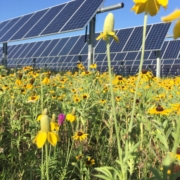Pollinator-Friendly Solar Pairs Economic Development, Conservation Goals
Written By: Cody Smith
As communities across the nation continue to embrace a future powered by clean energy, new solar farms are offering an opportunity to pair economic development and conservation goals. As landowners, project developers, and local officials work to enhance the value of these new project sites for the communities hosting them, investments in native vegetation can open the door for a variety of opportunities to grow the local economy while simultaneously promoting clean water, soil health, and wildlife habitat.
Solar energy is rapidly expanding in many states as utilities and consumers seek cheaper, cleaner alternatives to meet their needs. In fact, in 2020 the utility-scale solar industry grew by 26%, fueling the rise of renewables to be the second most prevalent source of electricity generation in the U.S. that year. With increased solar deployment, many communities are enjoying new jobs and tax revenue. In fact, across the Midwest, the solar industry employed nearly 37,000 workers as of 2019.

As more project sites are selected and leases are negotiated between landowners and project developers, prioritizing these investments can ensure that these new sites add value to all stakeholders in the process. Investments in native vegetation have been shown to increase the populations of pollinating insects, such as honey bees and native bees, by as much as three and a half times more than sites without such investments, according to the Iowa State University STRIPS Project. Meanwhile, vulnerable birds, such as the sedge wren in the Midwest, can utilize these new investments as much-needed habitat, helping protect wildlife biodiversity.
Well-maintained native vegetation is also an effective practice for improving water quality. Even modest investments in perennial native vegetation have demonstrated a 60 percent reduction in nitrogen loss and a 90 percent reduction in phosphorus loss to surrounding lakes, rivers, and streams. Retaining those nutrients on-site helps prevent the damaging impacts of harmful algal blooms in the watershed and improves overall soil health.
A common concern among landowners and residents debating whether or not utility-scale solar is a good fit for their community is the loss of productive agricultural land for this purpose. Local officials and developers should not stray away from these challenging conversations, though it is important to highlight these sites as an opportunity to continue agricultural production, even if it looks different than a traditional crop rotation of corn and soybeans. By introducing livestock grazing with a robust rotational grazing plan, farmers can both continue to diversify their incomes and grow the local economy without minimizing the positive environmental impacts described above.
In all, investments in native vegetation on solar project sites have shown they can both complement economic development goals and improve environmental conditions for the surrounding community, adding significant value to the projects. As developers, local officials, and landowners continue to contemplate whether or not pollinator-friendly solar is a good fit for them, this webinar titled Native Vegetation + Solar Energy from the Center for Rural Affairs can serve as a resource for planning for, managing, and implementing these types of projects.


